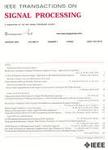版权所有:内蒙古大学图书馆 技术提供:维普资讯• 智图
内蒙古自治区呼和浩特市赛罕区大学西街235号 邮编: 010021

作者机构:Northeast Normal Univ Sch Math & Stat Key Lab Appl Stat MOE Changchun 130024 Peoples R China Imperial Coll London Dept Elect & Elect Engn London SW7 2AZ England
出 版 物:《IEEE TRANSACTIONS ON SIGNAL PROCESSING》 (IEEE Trans Signal Process)
年 卷 期:2025年第73卷
页 面:508-518页
核心收录:
基 金:Science and Technology Development Plan Project of Jilin Province [20240101370JC] National Natural Science Foundation of China Department of Science, Technology and Information of the Ministry of Education [8091B042240]
主 题:Quaternions Vectors Signal processing Lower bound Calculus Signal processing algorithms Covariance matrices Maximum likelihood estimation Three-dimensional displays Image color analysis Quaternion Cramer-Rao lower bound quaternion constrained Cramer-Rao lower bound quaternion Fisher information matrix quaternion parameter estimation GHR calculus
摘 要:The Cramer-Rao lower bound (CRLB) is a fundamental result in statistical signal processing, however, the CRLB for quaternion parameters is not yet established. To this end, we develop the theory of quaternion Cramer-Rao lower bound (QCRLB), based on the generalized Hamilton-real (GHR) calculus. For generality, this is achieved in a way that conforms with the real and complex CRLB. We first provide the properties of the quaternion covariance matrix and the quaternion Fisher information matrix (FIM), paving the way for the derivation of the QCRLB. This serves as a basis for the formulation of the QCRLB without constraints and a criterion for determining whether the QCRLB is attained. We also establish the QCRLB for constrained quaternion parameters, including both nonsingular and singular cases of the quaternion FIM. These broaden the theoretical framework and enhance its applicability to diverse practical scenarios. The practical efficacy of the QCRLB is demonstrated through two illustrative examples. Numerical validations confirm that the maximum-likelihood estimator (MLE) attains the QCRLB for the linear model, and the quaternion gradient ascent (QGA) algorithm achieves the QCRLB at each iteration with theoretical guarantees. We also propose the quaternion constrained scoring (QCS) algorithm, which converges in one step in the linear constrained MLE case, for the linear model. These results significantly contribute to both the theory and practical application of quaternion signal processing, bringing valuable insights into the quaternion parameter estimation.